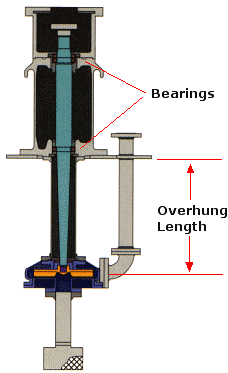Cantilever Pumps Information
Cantilever pumps are specialized centrifugal pumps utilizing a cantilever design in which only the impeller and casing are submerged in the tank or sump. All joints, including seals, bearings, bushings, and suction check valves, are located out of the fluid. This design is ideal for moving slurries and abrasive solutions that could degrade or interfere with submerged joints. They are the standard choice for moving abrasive media.
Pump Operation
Cantilever pumps are centrifugal pumps, relying on one or more impellers to draw and move fluid. For more information on the principles of centrifugal pump operation, visit the Centrifugal Pumps information page on Engineering360.
Cantilever pumps get their name from the cantilever structure, which is a beam supported at only one end (e.g. a diving board).
Similarly, cantilever pumps contain all joints, supports, and bearings at one end, allowing the other end to be inserted into the abrasive media without it interfering with the connections. Thus, the impeller is "cantilevered" from the motor instead of being supported by lower bearings. While most cantilever pumps are mounted vertically (suited for most tanks and sumps), some are designed horizontally based on the placement needs of the application.

Vertical cantilever pump diagram indicating bearing locations and the overhung length. Overhung lenth is the distance between the minimum-starting and maximum liquid levels.
Image Credit: Lawrence Pumps
Specifications
The primary specifications to consider when selecting cantilever pumps are flowrate, pump head, pressure, horsepower, power rating, outlet diameter, and operating temperature.
- Flowrate describes the rate of volume discharge through the pump.
- Head defines the energy supplied to liquid (per unit weight) by the pump. It is expressed as a column height of liquid (either vertical lift or suction), given in feet of head (ft).
- Pressure describes the operational pressure of the pump. It is usually given in pounds per square inch (psi) or bar.
- Horsepower indicates the output power of the pump, measured in units of horsepower (hp).
- Power rating indicates the power required to operate the pump, measured in Watts (W) or horsepower (hp). In the case of electric pumps, some manufacturers will instead specify the required voltage (in volts or V) and current (in amps or A). The power rating is the product of the voltage and current ratings (power = voltage x current).
- Outlet diameter is the size of the discharge or outlet connection of the pump. Inner diameter (I.D.) describes the size of the inner opening while outer diameter (O.D.) specifies the entire opening size including the pipe thickness.
- Operating temperature defines the range of temperatures or temperature limit of the media handled by the pump.
Selection tip: Selections above 70 hp should be reviewed carefully from a bearing and mechanical seal reliability standpoint before making a purchase.
For a more in depth understanding of pump specifications, performance curves, and operation, visit the Pump Flow information page on Engineering360.
Features
Many varieties of cantilever pumps are designed with additional features to allow for long service life in demanding conditions.
- Shaft-mounted agitators are installed to stir settled solids, helping to maintain a clean and maintenance free sump. Pump life is increased due to this reduction of cycling.
- Some varieties are designed for continuous operation, allowing continual use and operation without wearing out.
- Many cantilever pumps can be run dry or with a loss of prime without sustaining damage.
For a complete description of different pump features, visit Engineering360's Pump Features page.
Stages
The number of stages in a pump indicates the number of impellers the pump utilizes. Higher stages are used for applications requiring higher flow or more pump head.
- Single stage impeller pumps have one rotor to impart motion to the fluid.
- Multi-stage pumps include all pumps with more than one stage, which offer the functionality of a number of pumps in a series. For example, double-stage pumps have two impellers and perform like two pumps linked in series.
Applications
Aside from sump pump applications, cantilever pumps are widely used in other applications where liquids or slurries are passed and processed, including mineral processing plants, steel mills, chemical plants, and industrial wastewater treatment facilities. They are the primary choice for handling abrasive solid media, and are also ideal for handling high temperature fluids. Cantilever usage is limited to shallow fluid depths less than 8 to 10 feet where a standard motor above the liquid level can be applied cost effectively. Pump cost increases exponentially with depth, since deeper sumps require larger shaft diameters to cantilever the impeller. Submersible pumps are thus better suited for deeper applications.
Design Tip: Cost effective cantilever pumps usually have shaft diameters of no more than 6 inches.
To view an overview of various pump applications, visit Engineering360's Pump Applications page.
